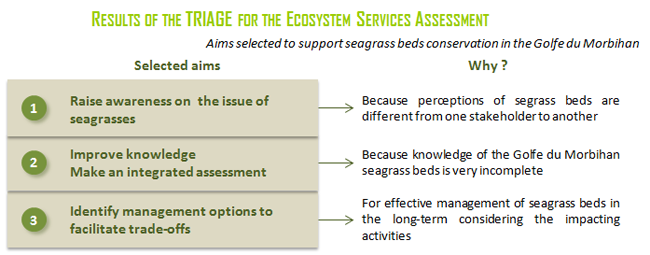5.6.5 Parc Naturel Régional du Golfe du Morbihan: Aims of the Ecosystem Services Assessment

The Parc Naturel Régional is the overall coordinator of the Natura 2000 area in the Golfe du Morbihan. This is an important area for seagrass beds, the second largest area in the metropolitan France after Arcachon.
Seagrass meadows are not algae but flowering plants. They live mainly on sandy-muddy substrates in sheltered marine areas. These remarkable habitats are protected at international, national and local level through different legislation and conventions (e.g. BERNE convention, OSPAR convention, European Habitat Framework Directive, local legislations.
Two species of seagrass are present in the Golfe du Morbihan: Zostera marina and Zostera noltei. In 2007, the seagrass beds represented, respectively 11 km2 and 8 km2.
Seagrass beds are sensitive to pressures impacting environmental quality (e.g. lack of light, herbicides, trampling, grubbing, etc.). Due to their high ability to regenerate in a healthy environment, they are used as a water quality indicator for the European Water Framework Directive.
In order to reconcile the environmental conservation with development of activities, the Parc Naturel Régional decided to experiment the Ecosystem Services Approach put forward in the VALMER project. The aim was also to provide new ideas and information that could be used for the revision of the Scheme for Sea Development, a marine planning tool in the Golfe du Morbihan, in 2016.
The Ecosystem Services Assessment was designed to:
- Raise awareness on seagrass issues
- Improve the management of seagrass beds through an integrated assessment
- Identify management options to facilitate trade-offs
The results of this Triage process ![]() are presented in the following table.
are presented in the following table.


